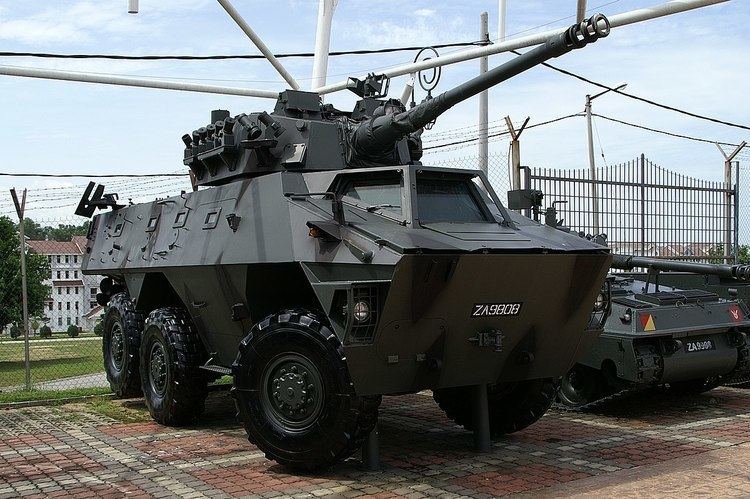Used by See Operator | ||
 | ||
Designed 1971 (initial prototype)1975 (SIBMAS) | ||
SIBMAS is a Belgian amphibious infantry fighting vehicle. It was engineered from the same prototype as the South African Ratel. In appearance the vehicle is also similar to the Chinese WZ-523 armoured personnel carrier. The SIBMAS was developed between 1975 and 1976 at a department of the BN Constructions Ferroviaires et Metalliques in Nivelles. Production was on an order-by-order basis and commenced only for the Malaysian Army.
Contents
Development History
Following trials with a number of prototypes, a subsidiary of the Büssing company in 1971 commenced the development of the Ratel infantry fighting vehicle to meet the requirements of the South African Army. After evaluating several alternatives, including the EE-11 Urutu, Thyssen Henschel UR-416, and the Panhard M3, South Africa purchased the rights to Büssing's final prototype, then identified as the "Springfield-Büssing Buffel". Büssing subsequently sold the same design to Belgium. The SIBMAS was still in the pre-production stage just as Ratel entered serial production. However, the obvious similarities between the two vehicles led some analysts to erroneously conclude their production was directly linked, and one was a licensed variant of the other.
Belgian engineers had completed a single SIBMAS demonstrator by the end of 1976 and proceeded to trial the vehicle in both Belgium and Malaysia. It was announced that production would not commence until a domestic or export order was finalised. Two amphibious demonstrators were later built, one which was propelled through water by its wheels at a speed of 5 km/h and a second with twin swivel-mounted propellers which could reach speeds of 10 km/h. The base model was armed with a 90mm Cockerill main gun, the same as that fitted to the EE-9 Cascavel as well as late production models of the Cadillac Gage V-150 Commando and FV101 Scorpion; this was designated Armoured Fire Support Vehicle 90, or simply "AFSV-90".
The Malaysian Army placed an order for 186 SIBMAS vehicles in 1981, as part of an $84 million deal with Belgium. This was accomplished under the auspices of Perkembangan Istimewa Angkatan Tentera (PERISTA), a general programme to greatly expand the firepower and mechanized capabilities of the Malaysian security forces, due in part to the ongoing communist insurgency and the escalating threat of a regional conflict between Thailand and Vietnam. Production of the SIBMAS for Malaysia began that year and concluded by 1985. About 162 SIBMAS AFSV-90s were manufactured, the remaining 24 being recovery vehicles with front and rear spades, a power winch, and a large, folding crane. The AFSV-90 replaced the Panhard AML, V-100 Commando, and Panhard M3 in Malaysian service, since it was able to more effectively combine the traditionally separate roles of an armoured car and an armoured personnel carrier onto a single vehicle.
Manufacturing rights to the SIBMAS design were later transferred to Cockerill; however, no further orders were received and production ceased accordingly.
In April 2016, the Malaysian government announced it would be looking into an extensive upgrade programme for its SIBMAS fleet, indicating the vehicle would remain in service for the foreseeable future. However, other sources maintain that the SIBMAS is being gradually retired and replaced by the eight-wheeled DefTech AV8.
Description
The long, box-shaped SIBMAS hull is of all-welded steel construction and provides the crew with protection from small arms fire and artillery fragments. Most SIBMAS variants possess a horizontal roofline, which slopes inwards at the rear. The engine compartment is located in the rear hull and to the left. Engine components are removed through the hull roof for servicing. Passengers may debark from a large door in the rear hull to the right. Entry doors and firing ports are also present in the sides of the vehicle, and there are three hull roof hatches for observation purposes. Drivers are seated at the front of the vehicle and provided with a single hatch cover and three large windows. The turret of the SIBMAS AFSV-90 is located near the hull front, immediately behind the driving compartment, and is provided with three large rectangular hatches.
The SIBMAS was built with power-assisted steering, automatic transmission, and run-flat tyres. It could also be fitted with night vision sights, a nuclear biological and chemical (NBC) protection suite, an electrical air conditioning system, heater, and a winch.
Without additional hull ammunition stowage, the SIBMAS could accommodate a maximum of sixteen passengers.
Variants
A menagerie of other variants were also offered for export but not adopted. This included a SIBMAS with a 30mm RARDEN autocannon, an anti-aircraft variant with twin 20mm autocannon, an anti-tank variant with a bank of HOT or MILAN missiles, a mortar carrier with the Brandt 60 mm LR Gun-mortar, a cargo transporter, a command vehicle, an armoured personnel carrier with a single 12.7mm heavy machine gun, and an ambulance with four litters.
In 2010, a SIBMAS was showcased mounting an LCTS90 weapon system by Cockerill. This variant is armed with a new 90mm medium-pressure gun capable of firing the Ukrainian-built Falarick 90 anti-tank guided missile.
